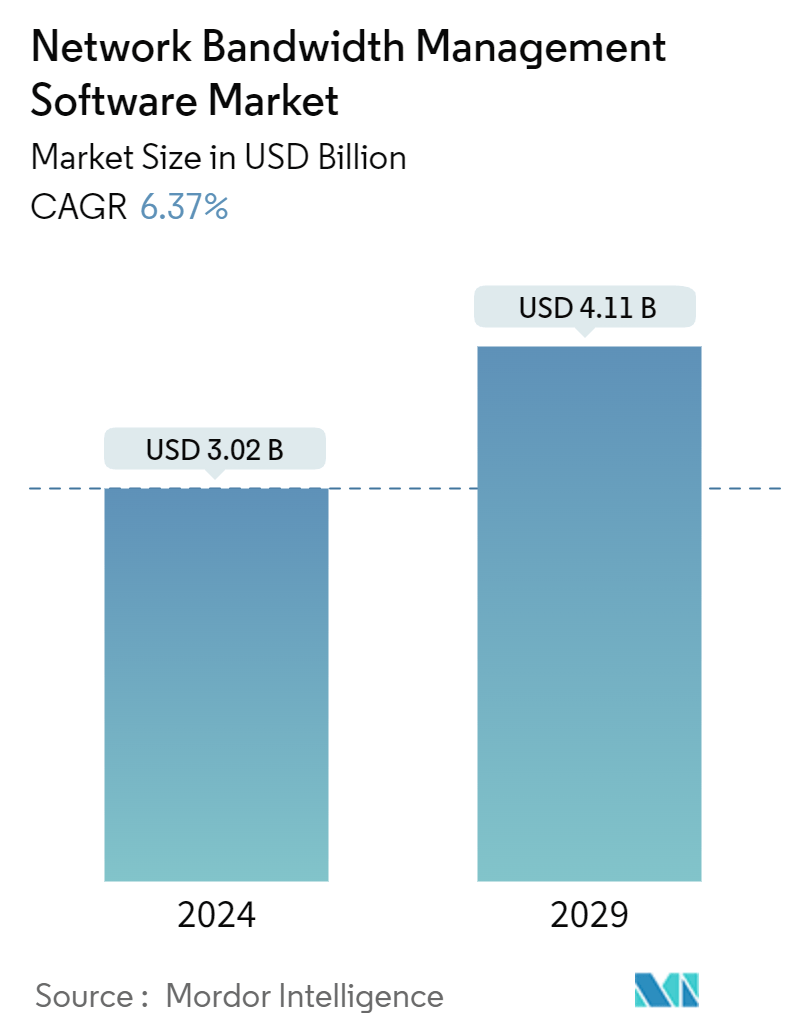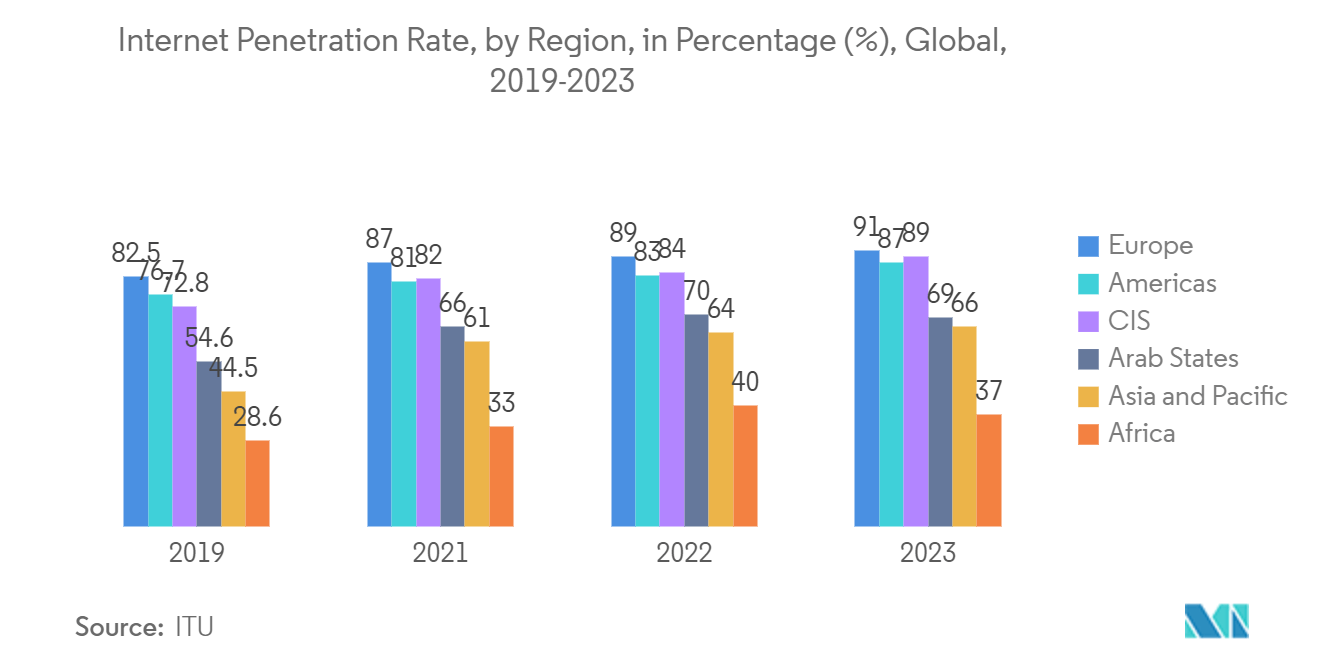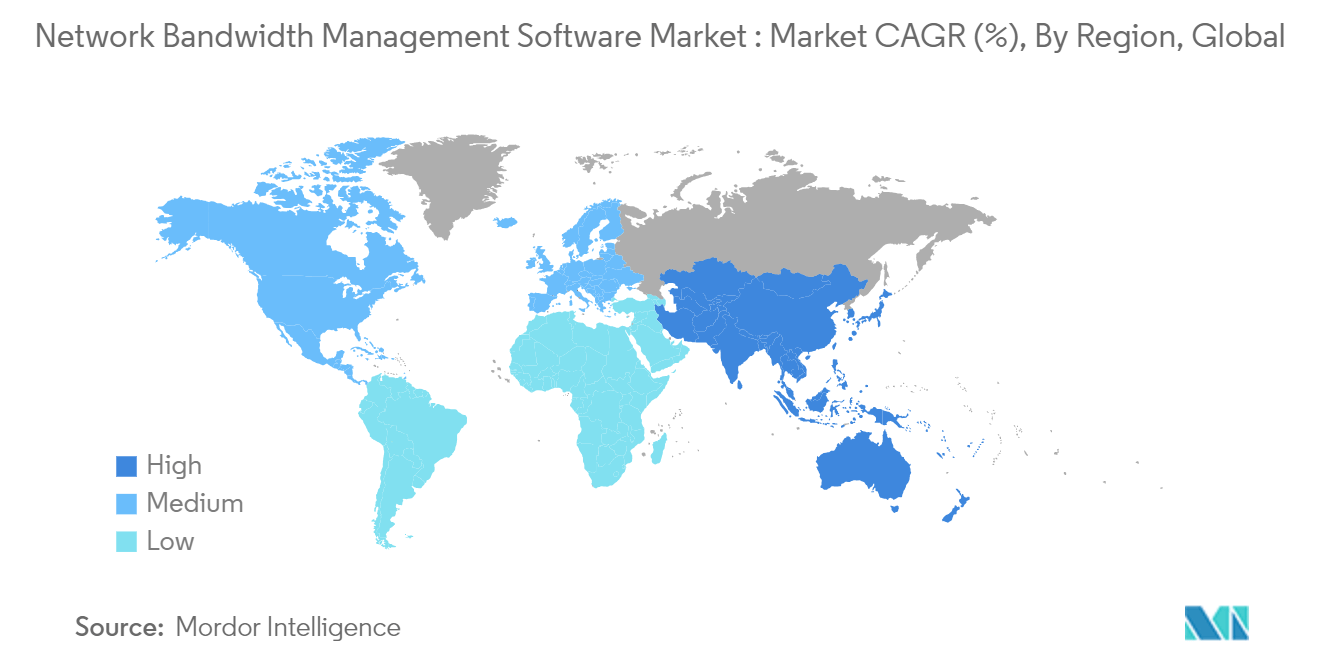Network Bandwidth Management Software Market Size

| Study Period | 2019 - 2029 |
| Market Size (2024) | USD 3.02 Billion |
| Market Size (2029) | USD 4.11 Billion |
| CAGR (2024 - 2029) | 6.37 % |
| Fastest Growing Market | Asia Pacific |
| Largest Market | North America |
Major Players
*Disclaimer: Major Players sorted in no particular order |
Need a report that reflects how COVID-19 has impacted this market and its growth?
Network Bandwidth Management Software Market Analysis
The Network Bandwidth Management Software Market size is estimated at USD 3.02 billion in 2024, and is expected to reach USD 4.11 billion by 2029, growing at a CAGR of 6.37% during the forecast period (2024-2029).
The overall network performance is adversely affected by excessive use of one part of the network, resulting in more delays and interruptions. The performance of networks not used by businesses is also influenced; therefore, real-time monitoring and management have become common practices in enterprises.
Automation and analytics are also rising with the increase in internet penetration. This leads to a surge of demand for high-speed Internet services in the commercial sector, which can cope with massive amounts of data without delay. The performance of private networks and the applications that rely on them for speed must be maintained to ensure privacy and data protection.
A considerable demand has been experienced by Internet service providers and mobile operators for network management software over the past decade, and telecom services vendors have grown due to an exponential growth of industrial IoT devices, in particular mobile phones. This is expected to increase and drive market growth bandwidth management during the forecast period.
Network bandwidth utilization is the rate at which data can flow through the network. Traditionally measured in bits per second (bps), higher bandwidth allows more traffic flow from one device to another.
However, market growth during the forecast period will be limited by budget constraints, including higher installation costs due to the maintenance and deployment of IAM solutions and a need for more knowledge about them.
Moreover, data flows increased in the wake of this COVID-19 pandemic. Many people have turned to the Internet and electronic learning and work. This increased demand for improved network bandwidth management software in the market. Therefore, several enterprises increasingly deploy network management solutions to protect data and optimize complex network processes.
Network Bandwidth Management Software Market Trends
The Telecommunication and IT Segment to Witness Significant Growth
- In today's world, digitization is revolutionizing how businesses operate. Digitalization means the digitization of information and the digitalization of data transmission and communication processes. The proliferation of cross-functional communication and data transfers is increasing with the emergence of agile and DevOps trends in IT. The low latency of the network compromises the process's effectiveness.
- In almost all sectors, from telecoms to information and communication technologies, the increase in Internet usage has penetrated its use. As per ITU, as of 2023, internet penetration in Europe was the highest worldwide, growing around 91% in the latest measured year. Due to this, the customers are becoming interested in the shift to OTT and IPTV.
- Also, telecommunications companies have partnered with OTT operators to gain market share. Therefore, these companies must manage their network bandwidth to cope with the smooth performance requirements of network bandwidth management software.
- Network bandwidth management software enables IT administrators to track and control the bandwidth of the enterprise network. Network delay is the root cause of many problems companies encounter when using the Internet. This software provides a service to reduce the delay during transmission and assign specifications.
- Corporate data breaches are frequent, and cybercriminals have effectively targeted many government and large-scale business networks. When credentials have been stolen or lost, companies will focus on securing the identification and access of their staff to avoid data exposure and other security breaches.
- With the real-time analysis of bandwidth usage and delays caused by the applications enabled by the increase in market share, the implementation of network bandwidth management software is gaining traction.

Asia-Pacific to Witness Major Growth
- Asia-Pacific's growth is expected to be the fastest, unlike the Rest of the World. In particular, the increasing number of small and medium-sized enterprises shifting their activities to a more extensive network is driving growth in this region. However, there are difficulties associated with managing networks.
- Moreover, this region is becoming an attractive market for numerous companies due to the cost advantage of growing economies and because several organizations have adopted today's state-of-the-art network management systems to increase their demand for unified network management.
- More regional organizations are taking advantage of cloud solutions to operate their business activities, which is likely to drive market growth due to the increasing demand for expertise in managing complex networks.
- In this region, a huge demand for network bandwidth management software arises due to the growing adoption of Internet of Things networks and other privately operated commercial networks, particularly in the financial services sector. Asia-Pacific relies heavily on cash for several transactions, notably in the retail sector, unlike most advanced economies worldwide. In order to meet the region's cash needs, ATMs and high-frequency networks that allow services to operate on a cycle basis should be constantly expanded.
- The demand for network bandwidth management software in this region is anticipated to increase during the forecast period due to the increased use of mobile devices, especially in countries such as India, China, and Indonesia.

Network Bandwidth Management Software Industry Overview
The network bandwidth management software market is fragmented, with increasing players offering network management software. As bandwidth management software is one of the parts of integrated network management software, the market competition is increasing. The key strategies adopted by the major players are product and service innovation and mergers and acquisitions.
In March 2024, Viasat Inc. announced Videosoft Global, which provides adaptive encoding and secure real-time video transmission over wireless networks, to its Velaris Partner Network, where the partnership will enable real-time video streaming capabilities over satellite communications, providing peace of mind to ground crews even in areas of poor terrestrial coverage, or tough network environments. This brings enhanced situational awareness to some of the most challenging environments on the planet.
In February 2024, NEC Corporation successfully demonstrated the end-to-end operation of their Open Virtual Radio Access Network (vRAN) and 5G Core Virtual User Plane Function (vUPF) products. This was achieved with Arm, Qualcomm Technologies Inc., Red Hat, and Hewlett Packard Enterprise (HPE). The demonstration used HPE ProLiant servers with Arm Neoverse-based CPUs and the Qualcomm X100 5G RAN Accelerator Card. The test was performed under conditions equivalent to a commercial environment, and Red Hat OpenShift was used as the platform for the demonstration.
Network Bandwidth Management Software Market Leaders
IBM Corporation
CA Technologies
Hewlett Packard Enterprise Company
NetScout Systems, Inc.
SolarWinds Corporation
*Disclaimer: Major Players sorted in no particular order

Network Bandwidth Management Software Market News
- March 2024: IBM announced the acquisition of Pliant, a leading network and IT infrastructure automation product provider. Pliant adds integral capabilities to automate network and IT infrastructure tasks and abstract these functions to the application layer, enabling applications (and developers) maximum control for simplified provisioning and infrastructure management directly within applications. These optimizations include infrastructure resource provisioning and management, traffic management, and infrastructure management for conventional network and IT infrastructure and public clouds.
- January 2024: Hewlett Packard Enterprise announced the acquisition of Juniper to expand its AI-native networking offerings, marking a significant shift in HPE's portfolio toward a more dynamic, high-margin networking business. The explosion of AI and hybrid cloud-driven businesses is accelerating the demand for secure, unified technology solutions that connect, protect, and analyze companies' data from the edge to the cloud.
Network Bandwidth Management Software Market Report - Table of Contents
1. INTRODUCTION
1.1 Study Assumptions and Market Definition
1.2 Scope of the Study
2. RESEARCH METHODOLOGY
3. EXECUTIVE SUMMARY
4. MARKET INSIGHTS
4.1 Market Overview
4.2 Industry Value Chain Analysis
4.3 Industry Attractiveness - Porter's Five Forces Analysis
4.3.1 Threat of New Entrants
4.3.2 Bargaining Power of Buyers/Consumers
4.3.3 Bargaining Power of Suppliers
4.3.4 Threat of Substitute Products
4.3.5 Intensity of Competitive Rivalry
5. MARKET DYNAMICS
5.1 Market Drivers
5.1.1 Growing Demand for IoT Networks and Commercial Private Networks in Enterprises
5.1.2 Increasing Demand for High-speed Internet Service in the Commercial Sector
5.2 Market Restraints
5.2.1 Availability of Free Network Traffic Tools
6. MARKET SEGMENTATION
6.1 By Deployment
6.1.1 On-Premise
6.1.2 Cloud
6.2 By Enterprise Size
6.2.1 Small and Medium Enterprises
6.2.2 Large enterprises
6.3 By End-user Vertical
6.3.1 Telecommunication & IT
6.3.2 Education
6.3.3 Retail
6.3.4 Healthcare
6.3.5 BFSI
6.3.6 Other End-user Verticals
6.4 By Geography***
6.4.1 North America
6.4.1.1 United States
6.4.1.2 Canada
6.4.2 Europe
6.4.2.1 Germany
6.4.2.2 United Kingdom
6.4.2.3 France
6.4.3 Asia
6.4.3.1 China
6.4.3.2 Japan
6.4.3.3 India
6.4.3.4 Australia and New Zealand
6.4.4 Latin America
6.4.4.1 Brazil
6.4.4.2 Argentina
6.4.4.3 Mexico
6.4.5 Middle East and Africa
6.4.5.1 United Arab Emirates
6.4.5.2 South Africa
7. COMPETITIVE LANDSCAPE
7.1 Company Profiles*
7.1.1 IBM Corporation
7.1.2 CA Technologies
7.1.3 Hewlett Packard Enterprise Company
7.1.4 NetScout Systems Inc.
7.1.5 SolarWinds Corporation
7.1.6 Alcatel- Lucent Enterprise Holding
7.1.7 GFI Software SA
7.1.8 Axence Software Inc.
7.1.9 Zoho Corporation
7.1.10 BMC Software Inc.
7.1.11 InfoVista SA
7.1.12 Juniper Networks Inc.
8. INVESTMENT ANALYSIS
9. MARKET OPPORTUNITIES AND FUTURE TRENDS
Network Bandwidth Management Software Industry Segmentation
Bandwidth management measures and controls the communications on a network link to avoid filling the link or overfilling the link, which would result in network congestion and poor network performance.
The network bandwidth management software market is segmented by deployment (on-premises and cloud), enterprise size (small and medium enterprises, and large enterprises), end-user vertical (telecommunication and IT, education, and retail), and geography (North America (United States, Canada, and Rest of North America), Europe (United Kingdom, Germany, France, and Rest of Europe), Asia-Pacific (China, India, Japan, and Rest of Asia Pacific), Latin America (Mexico, Argentina, Brazil, and Rest of Latin America), and Middle East and Africa (United Arab Emirates, Saudi Arabia, South Africa, and Rest of the Middle East and Africa)). The market sizes and forecasts are provided in terms of value (USD) for all the above segments.
| By Deployment | |
| On-Premise | |
| Cloud |
| By Enterprise Size | |
| Small and Medium Enterprises | |
| Large enterprises |
| By End-user Vertical | |
| Telecommunication & IT | |
| Education | |
| Retail | |
| Healthcare | |
| BFSI | |
| Other End-user Verticals |
| By Geography*** | ||||||
| ||||||
| ||||||
| ||||||
| ||||||
|
Network Bandwidth Management Software Market Research Faqs
How big is the Network Bandwidth Management Software Market?
The Network Bandwidth Management Software Market size is expected to reach USD 3.02 billion in 2024 and grow at a CAGR of 6.37% to reach USD 4.11 billion by 2029.
What is the current Network Bandwidth Management Software Market size?
In 2024, the Network Bandwidth Management Software Market size is expected to reach USD 3.02 billion.
Who are the key players in Network Bandwidth Management Software Market?
IBM Corporation, CA Technologies, Hewlett Packard Enterprise Company, NetScout Systems, Inc. and SolarWinds Corporation are the major companies operating in the Network Bandwidth Management Software Market.
Which is the fastest growing region in Network Bandwidth Management Software Market?
Asia Pacific is estimated to grow at the highest CAGR over the forecast period (2024-2029).
Which region has the biggest share in Network Bandwidth Management Software Market?
In 2024, the North America accounts for the largest market share in Network Bandwidth Management Software Market.
What years does this Network Bandwidth Management Software Market cover, and what was the market size in 2023?
In 2023, the Network Bandwidth Management Software Market size was estimated at USD 2.83 billion. The report covers the Network Bandwidth Management Software Market historical market size for years: 2019, 2020, 2021, 2022 and 2023. The report also forecasts the Network Bandwidth Management Software Market size for years: 2024, 2025, 2026, 2027, 2028 and 2029.
Network Bandwidth Management Software Industry Report
Statistics for the 2023 Network Bandwidth Management Software market share, size and revenue growth rate, created by Mordor Intelligence™ Industry Reports. Network Bandwidth Management Software analysis includes a market forecast outlook to 2029 and historical overview. Get a sample of this industry analysis as a free report PDF download.
